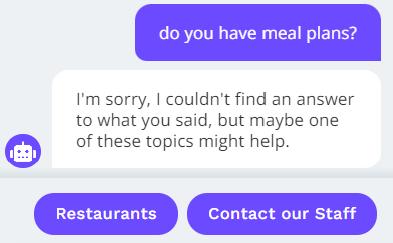Understand how our pre-stay chatbot works
Applicable to all subscriptions
Our Pre-Stay chatbot allows website users to:
- Check availability, rates and book a room
- Ask questions about your property
- Contact the team directly if needed
Note: This chatbot can also be connected to other channels. Click here to learn more
How does it work?
When the user initiates a conversation with the chatbot, the user will receive an automatic greeting message from the chatbot and is given a few options to select from. This is the decision tree.
The user can then opt to follow the pre-defined decision tree by selecting the given options or can write and send an open-ended message.
There are 5 major parts to the pre-stay chatbot:
Decision tree
The pre-stay chatbot uses a decision tree to help guide the users and help them find topics in an easier manner.
A standard decision tree for our pre-stay chatbot will look something like this:

Intent detection and learning
Whenever the user sends a written message, the chatbot will try to identify what the user is inquiring about by matching it to one of the topics or flows the chatbot was taught beforehand, based on the topics filled in by you in the console (Chatbots Menu).
After it detects the user's intent, the chatbot will then attribute a score on how confident it is that the intent detected is the correct one. The higher the score, the more chances of it being correct. Usually, 70% or above is a very good confidence score.
After processing the users' query, there are the following possible outcomes:
- If it detects an intent with a confidence score equal or superior to the pre-defined threshold (by default 70%), the chatbot returns an automatic answer (if the answer exists) or begins a flow;

- If it detects an intent with a confidence score equal or superior to the pre-defined threshold (by default 70%), but there isn't an answer or flow for that intent, the chatbot sends the conversation to the staff;


- If it detects an intent with a confidence score equal or superior to the pre-defined threshold (by default 70%), but already gave the answer to that intent the moment before, the chatbot sends the conversation to the staff - see more about duplicate intents;


- If it detects a topic with confidence between 40% and 70%, it asks the user if the topic being asked about is really that one or a similar one, and then the user can select one of those topics or select to speak with the staff - see more about similar intents;

- If it doesn't detect any intent or the intent it detected is below 40%, it automatically sends the conversation to a human agent.


Whenever the chatbot does not understand a query, that is, does not detect an intent with a good enough confidence score (>70%), that sentence will be added to HiJiffy's query pool. We kindly ask you to report these messages in the console to be analyzed and taught to the chatbot. With time, more intents and more queries are added to the chatbot and it will get smarter, understanding more phrases and word combinations in each intent.
How to report a sentence in the console?
Automated responses
Automated responses are all the responses the chatbot has pre-configured to return to the user when it detects a certain intent or after a certain action taken on the decision tree, such as the user selecting a button.
An automated response can consist of text, templates with images and buttons, and quick reply buttons. The majority of automated responses in a chatbot will usually be the ones created to reply to FAQs. You can see more about how to edit your Automatic replies to FAQs in here.
Flows
A flow in the chatbot consists of a sequence of predefined steps with the goal of collecting information from the user. Each step consists of a question that requires user input (whether by typing or selecting an option) to move to the next question.
At the end of the flow, the chatbot will return a link or a feedback message, depending on the type of flow. There are currently two types of flows:
- Link-generating flows;
- Request flows.
A link-generating flow will return, at the end of the flow, a link using parameters according to the answers given in the flow. The most common use is to generate a room search link with, for example, the check-in and check-out dates.
A request flow will generate a request in the Console for your team to manage. For more information regarding Requests, please check this guide.
To learn about all existing flows in the pre-stay solution, click here.
Note: Request flows are not available in solutions with 100% automation
Human handoff
Whenever the chatbot is unable to help the user (following the scenarios outlined above) or the user explicitly requests to talk to someone (by selecting to chat with staff from the options given or by asking for it), the chatbot will transfer the conversation to the HiJiffy console for a human agent to handle.